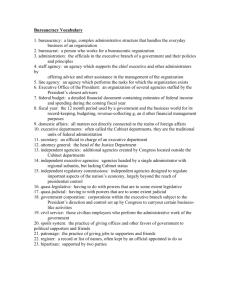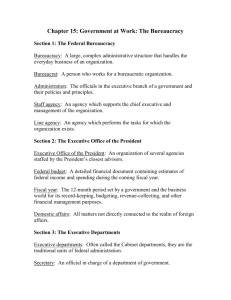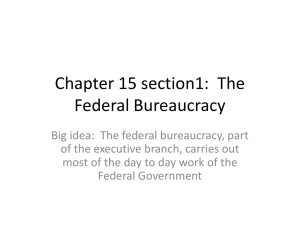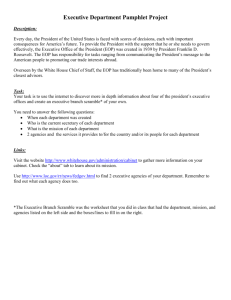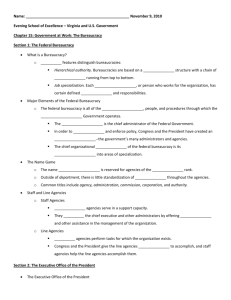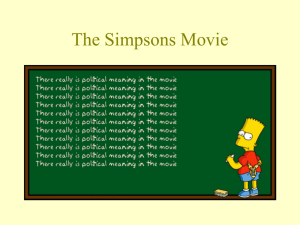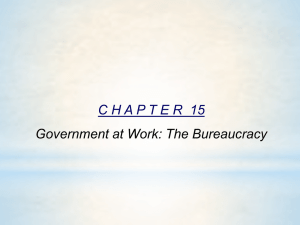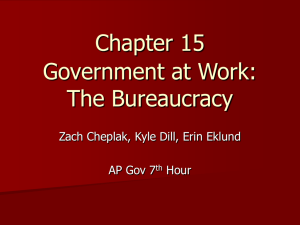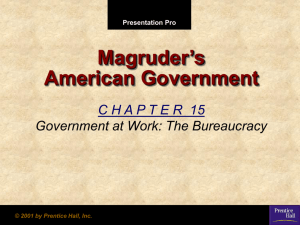Chapter 15 PPT - Ash Grove R
advertisement
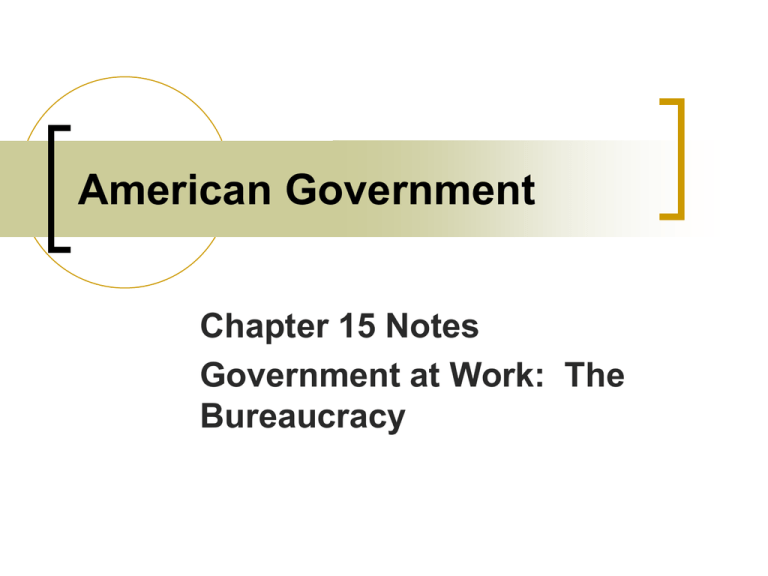
American Government Chapter 15 Notes Government at Work: The Bureaucracy Section 1 The Federal Bureaucracy What is a Bureaucracy A large, complex administrative structure that handles the everyday business of an organization It is an efficient and an effective way to organize people to do work… most of the time Three Features of a Bureaucracy Hierarchical authority Job Specialization Chain of command Each Bureaucrat has a certain defined duty and responsibility Formalized Rules The Benefits of a Bureaucracy Generally the most effective way to work together on a large and complex task Major Elements of the Federal Bureaucracy All the agencies, people, and procedures through which the Federal Government operates Not spelled out specifically in the U.S. Constitution Must have an effective administration The government’s many administrators and agencies The Name Game Sometimes names refer to level of importance that the unit of the Executive branch has However, there is little standardized use of titles Staff and Line Agencies The several units that make up any administrative organization can be classified as either staff or line agencies Staff agencies They aid the chief executive and other administrators by offering advice and other assistance in the management of the organization Line agencies Actually perform the tasks for which organizations exists Section 2 The Executive Office of the President The Executive Office of the President (EOP) Is an umbrella agency, including all the separate agencies with the job of helping the President enforce the laws The White House Office The “nerve center” of the Executive Office is the White House Office Most of the work is done in the Historic West Wing Chief of Staff to the President directs all of the operations of the White House Office Including Press Secretary, The counsel, and the President’s physician The National Security Council Most foreign policy issues are taken care of by the National Security Council (NSC) Includes Vice President, secretaries of state and defense, Head of CIA and chairman of the Joint Chiefs of Staff Office of Homeland Security Newest EOP, created in response to September 11 Work to protect this country against any and all acts of terrorism Other EOP Agencies Office of Management and Budget (OMB) 2nd most influential unit in the EOP Main task is preparation of the federal budget A very detailed estimate of receipts and expenditures, an anticipation of federal income and outgo, during the next fiscal year Fiscal year is the 12-month period used by government and business for record keeping Lasts from October 1 through September 30 Expression of public policy in money terms Manages much of the actions of other agencies, to verify that they are spending according to the President’s policy positions Other EOP Agencies (Con’t) Office of Faith-Based and Community Initiatives Office of National Drug Control Policy Council of Economic Advisers Gives the President advice on the state of the U.S. economy Other Units in the EOP Includes agencies that take care of the domestic affairs All matters not directly connected to the realm of foreign affairs Section 3 The Executive Departments Executive Departments Often called the Cabinet departments, they are the traditional units of federal administration, and each of them is built around some broad field of activity Chief Officers and Staff Each department is headed by a secretary Except Department of Justice An official in charge of a department of government Directed by the Attorney General These positions must be approved by the Senate Executive Departments (Con’t) Subunits Allow the department to meet different specific needs The Departments Today Department of State is the oldest and most prestigious Department of Defense is the largest There is a total of 15 Departments Including Department of Labor The Cabinet An informal advisory body brought together by the President to serve their needs The Cabinet is generally formed by the 15 Executive Departments Appointees to the Departments must be approved by the Senate Women and Minorities Has gradually played a greater role in the Cabinet, since FDR The Cabinet’s Role Mainly to be advisers to the President, however it is not called for in the Constitution A tradition President’s have carried on
